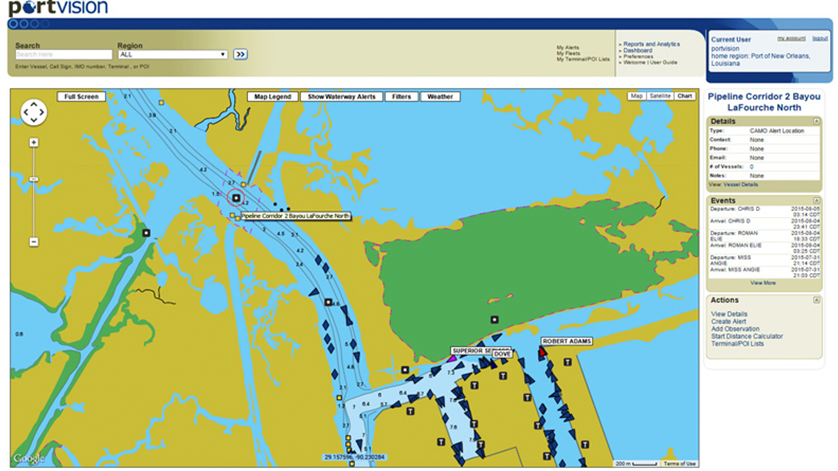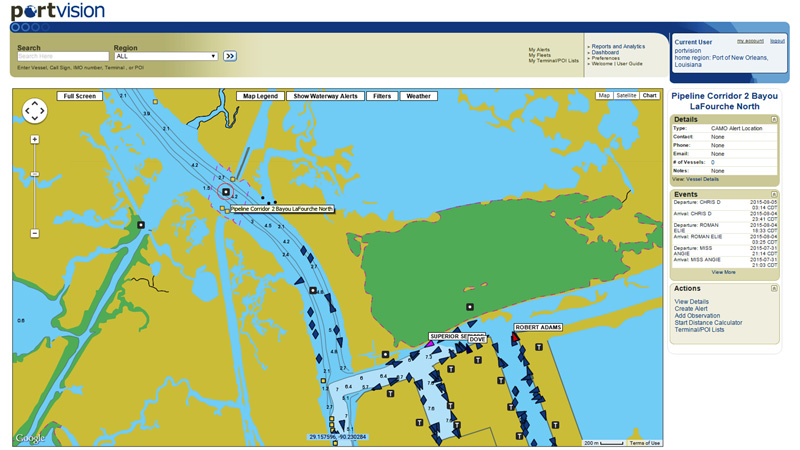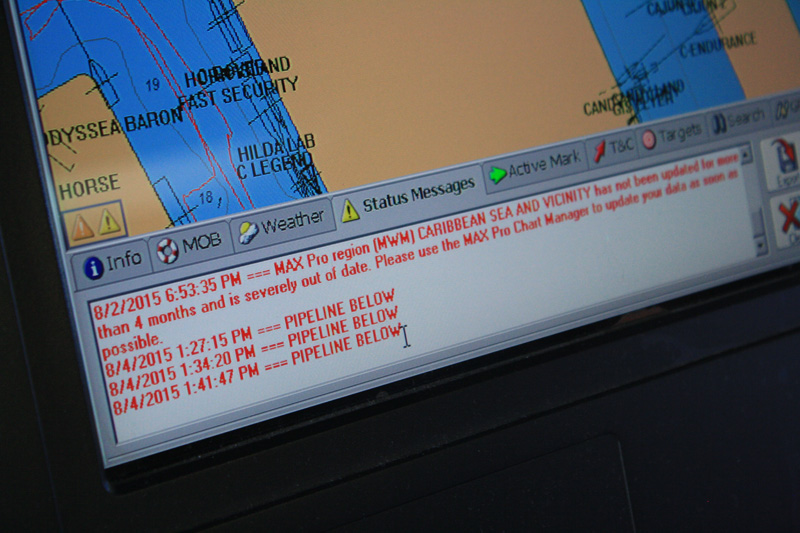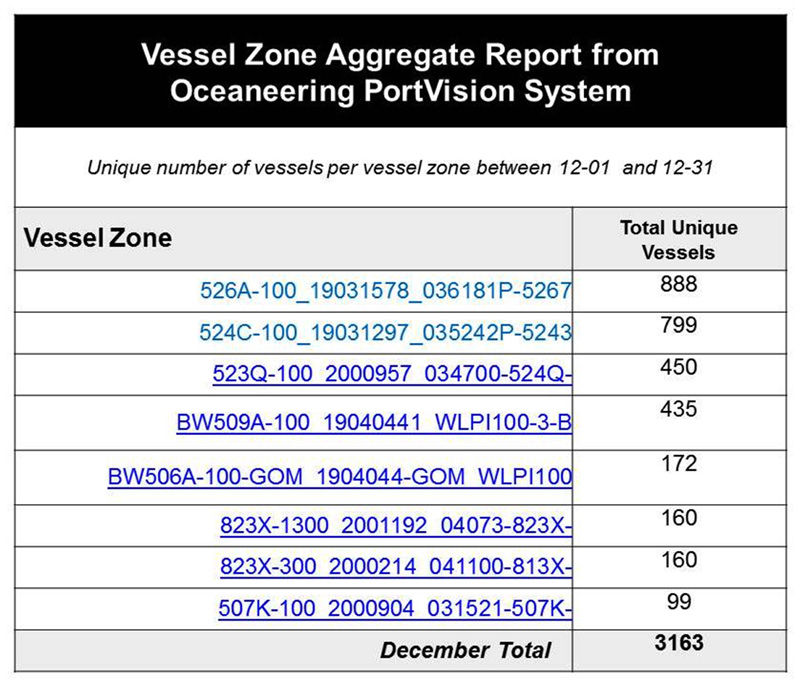October Feature Story - Global Data Solutions (GDS)/PortVision

Protecting Maritime Assets
By: Jason Tieman
Oceaneering Director of Maritime Solutions, Global Data Solutions (GDS)/PortVision
Safety and security are as important as operational efficiency for owners of geographically dispersed maritime assets and remote infrastructure. These organizations are increasingly much more proactive about monitoring and responding to the threat that vessels pose to assets including pipelines, offshore rigs and other fixed infrastructure above and below the water. When a vessel comes into contact with these assets, it can lead to unplanned and expensive surveys, repairs, costly litigation, and the potential of third-party claims for the economic and environmental impacts of a spill in the maritime environment.

Pipeline corridor being monitored for vessels that could be a threat.
Operators of these assets now have a new tool for threat assessment and mitigation planning, using the same Automatic Identification System (AIS) data that all major oil companies employ today to optimize their operations by better understanding vessel movements globally. These tools increase visibility to real-time vessel positions and historical commercial vessel traffic, and also include activity logging, process management, business analysis and reporting capabilities, while giving users a single operational dashboard to improve the productivity, safety and efficiency of multiple assets and/or fleets.
This technology provides operators of remote assets with the monitoring and analytical capabilities for assessing the threat of encroaching vessels, and also provides the opportunity for preemptive alerting when nearby vessel activity suggests that a strike may be imminent. In addition to leveraging the AIS signal required by most vessels, radar can also be used to assess the threat of those vessels that might not be required to carry an AIS transponder. These tools completely transform the ability for operators to make accurate, fact-based assessments of imminent threats to their infrastructure by using real-time vessel position data while also measuring historical trends in great detail to better direct the funding of surveys, maintenance and riskmitigation strategies.
When AIS is combined with radar and other data sources, it provides a more complete picture of vessels moving around marine infrastructure. As an example, many offshore oil platforms already have radars that can be combined with AIS data for enhanced web-based vessel-monitoring solutions. Radar is a particularly important data source since its use ensures that even vessels that are not transmitting AIS signals can be monitored to determine if the vessels appear to pose a threat.
There is an additional security advantage to using radar, considering that not all vessels have AIS and that radar cannot be tampered with. There have been many cases in which operators have altered their data and falsely represented their actions or position details, or have simply turned off their AIS transponders. The use of radar, however, ensures that these vessels are still visible, both in real time and for historical tracking purposes.
Redefining responsibilities for collision avoidance
According to international and inland navigation rules, every vessel bears the responsibility for preventing collisions, and must maintain an appropriate lookout by using all available means to determine if the risk of collision exists, based on prevailing circumstances and conditions. Traditionally, operators of fixed assets were only obligated to deploy passive measures to mitigate the risk of vessel interactions, but, with the growing availability and affordability of new technology, there also is the growing expectation for this technology to play a key role in proactively preventing an incident. Today’s AIS-based analytical tools give infrastructure operators everything they need to actively collaborate with vessel operators on collision avoidance by continuously assessing AIS vessel position data and/or radar information. With these tools, operators can not only preempt strikes before they occur, but they can also achieve a more comprehensive vulnerability picture so they can improve their risk mitigation strategies.

To alert a vessel, a warning is sent directly to the unique Maritime Mobile Service Identity (MMSI) that is assigned to its AIS transponder.
The first entity to use AIS as a method to communicate safety information directly to a vessel for marine asset protection was the Coastal and Marine Operators (CAMO) group, which launched a pipeline monitoring program in August 2015 in partnership with the Greater Lafourche Port Commission in Louisiana and with Oceaneering International, Inc. The CAMO initiative uses Oceaneering PortVision AIS-based vessel-monitoring service to monitor and automatically alert vessel operators that might be slowing, stopping or anchoring inside two pipeline corridors – charted by the U.S. National Oceanic and Atmospheric Administration (NOAA) and located north and south of Port Fourchon – that pass under its main navigable channel. Their success has provided a model for broader industry deployment.
Deploying an asset protection solution
The first step in implementing a maritime asset protection solution is to assess the asset's location to determine the type of traffic that is expected in the region, and to decide if there is value in deploying an AIS Aid to Navigation (ATON) and the ability to do so. An AIS ATON can be associated with either a real or virtual ATON, and is capable of transmitting safety messages to vessels within range. Any organization can apply for an AIS ATON for its pipeline or other fixed asset through a U.S. Coast Guard application process and a supporting Federal Communications Commission (FCC) application. Once an AIS ATON is in place, nearby vessels can then be alerted of a specific asset location. The AIS ATON can also be configured to send a safety message to the wheelhouse of the encroaching vessel to warn its captain and crew of a specific threat. This message can be designed so that it is only transmitted when an approaching vessel operates in a way that appears to threaten the asset.
Some pipeline operators are currently monitoring their entire submerged pipeline infrastructure for vessel activity, and proactively investigating threats based on triggered alerts to their pipeline monitoring team. Pipeline companies’ proactive monitoring has already resulted in multiple positive communications with vessels detected near a pipeline – situations that, without this monitoring capability, might otherwise have resulted in marine casualties.
As pipeline operators employ these tools and assess traffic volumes, the way they use AIS data continues to evolve. In many cases, these operators have uncovered high-risk pipeline segments that were previously believed to have minimal or no traffic passing over them. Operators are developing risk matrices based on their pipelines’ depth of cover and traffic volumes, as well as information about vessel type and draft of the passing vessels across up to five years of historical tracking data. This is greatly improving their risk assessments, enabling them to more effectively target how maintenance funds should be spent and where outreach campaigns should be focused. For instance, operators are now even able to identify specific vessels or fleet owners for outreach and education if they appear to be consistently operating near their infrastructure.

Assessing each pipeline segment to determine actual vessel traffic is relatively new data for pipeline companies and has significantly changed how they assess where funding is spent for risk mitigation and outreach strategies.
Advantages of centralized monitoring
While some operators already have a centralized team monitoring their assets for production and other purposes, in some cases, there is a need to develop a separate team or process to proactively monitor and respond to alerts triggered by vessels that appear to be a threat. Ideally, owners of remotely operated fixed structures should be able to establish a “virtual watch team” to assess threats for multiple remote assets or large areas of subsea infrastructure, anywhere in the world. By centralizing the processing and management of AIS and other remote data sensors to a single location, all assets and infrastructure can be monitored and assessed consistently with the same process and tools used by professionals who are experienced with vessel operations.
Centralized monitoring is particularly valuable for operators of offshore infrastructure. It offers them a number of advantages over monitoring at multiple independent locations. Following are some of the values of a team focused on these specific threats:
- The team’s training in standard operating procedures can be more easily applied across multiple assets.
- The center can manage all relevant systems and communications methods to identify threats and to hail encroaching vessels, including monitoring AIS, radar and other data sensors, as well as any third-party sources of AIS, weather, news and related information as applicable per region.
- Effective processes and supporting hardware can be easily measured and assessed, resulting in all assets benefiting quickly from lessons learned and technology/hardware improvements.
- Labor costs can be reduced, as the need for multiple peoplein various locations is removed and a centralized monitoring team applies its focus and skills toward assessing risk for multiple assets and preventing the reliance on tasking multiple people with another collateral duty that is not their core focus.
- An optimal team comprises professional mariners who can quickly validate if a vessel’s actions represent a true threat – greatly reducing the costs associated with prematurely deploying additional resources to assess the situation.
- Some operators may even outsource monitoring, thus relieving operators of the need to invest in the infrastructure and to staff a qualified team.
Today’s asset protection solutions can be managed by a shore-based operations center that is staffed and equipped to implement the most effective strategy for combating threats to maritime infrastructure globally. Now, with the advent of AIS-based tools for vessel monitoring, analytics and preemptive alerting, this centralized operation could have at its disposal all the resources required to effectively monitor the safety of the organization’s assets and the environments in which they operate. PortVision and Oceaneering are registered trademarks of Oceaneering International, Inc.

